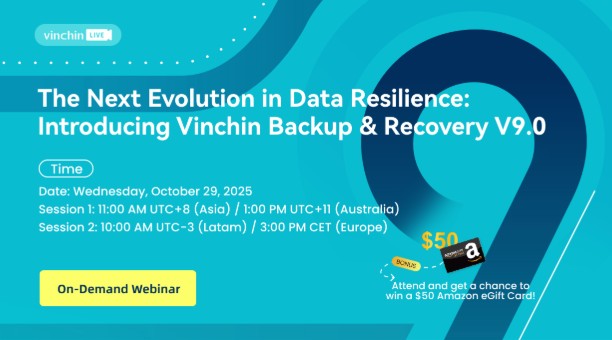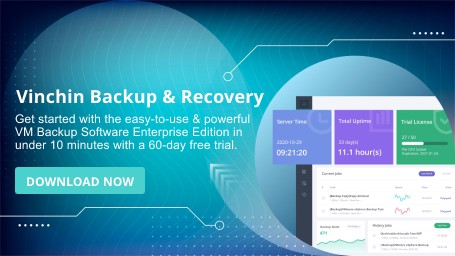-
Retail Banking Data Characteristics
-
Retail Banking Backup Challenges
-
Common Backup Methods in Retail Banking
-
Vinchin’s Data Protection Solution for Retail Banking
-
Retail Banking Data Backup FAQs
-
Conclusion
Retail banking has changed rapidly in the digital age. Today, banks rely on IT systems to process millions of transactions, manage customer accounts, and deliver services through online and mobile channels. This digital transformation brings new opportunities—but also new risks. A robust retail banking data backup solution is now essential for business continuity, regulatory compliance, and customer trust. Without reliable backups, a single outage or cyberattack could disrupt operations, cause financial loss, or even damage a bank’s reputation. So, what makes data backup in retail banking so unique and challenging?
Retail Banking Data Characteristics
Retail banks generate and store vast amounts of data every day. The growth is driven by digital transactions, online and mobile banking, ATM networks, and branch operations. Core banking systems, customer relationship management (CRM) platforms, and payment gateways are just a few of the main applications producing this data.
What sets retail banking data apart? First, it is highly sensitive. Banks handle personal and financial information, including account numbers, transaction histories, and identification details. This data must be protected at all costs. Second, strict retention policies apply. Regulations require banks to keep records for years, sometimes decades. Third, the data comes in both structured formats (like databases) and unstructured formats (such as emails or scanned documents). Finally, many banking processes require real-time data access and updates, making downtime or data loss unacceptable.
Retail Banking Backup Challenges
Designing a retail banking data backup solution is not simple. Banks face several major challenges:
Data Volume Management: The sheer amount of data generated daily can overwhelm traditional backup systems. Banks must find ways to back up large datasets quickly and efficiently.
Stringent Compliance Requirements: Regulations like GDPR and PCI DSS demand strict data protection, privacy, and retention. Non-compliance can lead to heavy fines and legal trouble.
High Availability Demands: Banking services must be available 24/7. Any downtime can disrupt customer transactions and erode trust.
Complex IT Environments: Banks often use a mix of legacy systems, modern applications, physical servers, virtual machines, and cloud services. Integrating backup across these platforms is a technical challenge.
Rapid Recovery Needs: In the event of a failure or cyberattack, banks must restore data and services quickly to minimize disruption.
Cybersecurity Threats: Ransomware, phishing, and other attacks target banks because of the value of their data. Backups must be secure and protected from tampering or deletion.
Do these challenges sound familiar? They are the reason banks need specialized backup strategies.
Common Backup Methods in Retail Banking
To address these challenges, banks use several proven backup methods. Each has its strengths and is often combined for maximum protection.
Full Backups: This method creates a complete copy of all data at a specific point in time. It is simple and reliable but can be time-consuming and storage-intensive.
Incremental Backups: Only data that has changed since the last backup is saved. This approach saves time and storage but requires all increments for a full restore.
Differential Backups: This method backs up all changes since the last full backup. It strikes a balance between speed and restore complexity.
Continuous Data Protection (CDP): CDP captures every change in real time, providing the most granular recovery points. It is ideal for critical systems where even a few minutes of data loss is unacceptable.
Cloud-based Backups: Data is copied to secure cloud storage, providing offsite protection and scalability. Cloud backups are useful for disaster recovery and regulatory compliance.
Tape Archiving: While older, tape remains a cost-effective way to store large volumes of data for long-term retention. Many banks use tape for regulatory archives.
Banks often combine these methods to meet their unique needs. For example, they might use full backups weekly, incremental backups daily, and cloud-based backups for offsite protection.
Vinchin’s Data Protection Solution for Retail Banking
Vinchin has already delivered data protection solutions to numerous enterprises in the retail banking industry. The platform stands out with its broad compatibility—supporting over 19 virtualization environments such as VMware®, Hyper-V®, Proxmox®, plus physical servers, databases, on-premises, or cloud file storage, meeting diverse IT architecture needs across retail banks.
If you need migration capabilities, Vinchin Backup & Recovery offers some of the most flexible options available today—enabling easy full-system migrations across any supported virtual, physical, or cloud hosts. For critical workloads running on virtual or physical machines,real-time backupandreplication*provide extra recovery points with automated failover—helping reduce both RPO (Recovery Point Objective)and RTO(Recovery Time Objective).
To ensure reliability,automatic integrity checksof backup files run regularly,and recoverability validation takes place in an isolated environment—guaranteeing your workloads can always be restored when needed.Vinchin also helps build resilient disaster-recovery systems by applyingautomated retention policies, archiving/backing up to cloud*,and establishing remote replicas/DR centers—for rapid recovery after incidents.
With its simple,B/S web consoleand wizard-driven workflows,users get started fast—even without deep technical skills.A free 60-day trial,comprehensive documentation,and responsive support engineers*make deployment smooth—so you protect your bank’s critical financial data efficiently.
Retail Banking Data Backup FAQs
Q1: How can banks ensure backup data meets regulatory retention requirements?
A1: By setting automated retention policies that align with legal mandates for data storage duration.
Q2: What is the best way to protect backup data from ransomware?
A2: Use immutable storage and regular integrity checks to prevent unauthorized changes or deletion.
Q3: How can banks minimize downtime during a disaster recovery event?
A3: Implement real-time replication and automated failover to enable rapid restoration of critical systems.
Conclusion
A robust data backup solution is essential for modern retail banks facing complex risks, strict regulations, and rising customer expectations. With the right strategy and tools, banks can safeguard sensitive information, ensure business continuity, and maintain customer trust. Vinchin provides a reliable, flexible, and secure approach to data protection, helping retail banks strengthen resilience in an ever-changing environment.
Share on:










